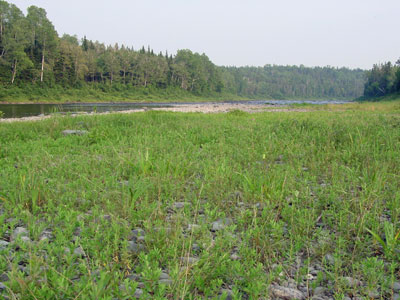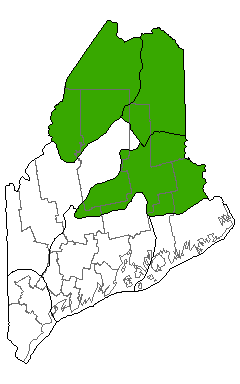DACF Home → Bureaus & Programs → Maine Natural Areas Program → Communities, Plants, and Animals → Natural Community Fact Sheets → Laurentian River Beach
Printer Friendly Fact Sheet - 730 KB pdf (Get a free copy of Adobe Acrobat Reader)
Laurentian River Beach
Scientific Name: Sand Cherry - Tufted Hairgrass River Beach; State Rank: S2

- Community Description
- Soil and Site Characteristics
- Diagnostics
- Similar Types
- Conservation, Wildlife and Management Considerations
- Distribution
- Characteristic Plants
- Associated Rare Plants
- Associated Rare Animals
- Examples on Conservation Lands You Can Visit
Community Description: These exposed river beaches feature sparse to extensive cover of low shrubs, forbs, and grasses, with species of northern affinity characteristic. Dominant plants include tufted hairgrass, roses, and mats of sand cherry. Poison ivy may be locally abundant. Canadian tick-trefoil, wild chive, New York aster, and freshwater cordgrass are characteristic herbs. Several rare plants such as Huron tansy, alpine sweet-broom, or alpine milk-vetch may be locally common. Bryoids are virtually absent. Back to top.
Soil and Site Characteristics: These are rivershores where coarse deposits remain after flooding and ice scour. The substrate is usually cobbly and often dry at the surface. Sites flood in the spring and may be partially underwater for brief periods in the summer. The slope is usually very slight and the sites are exposed to full sun. Back to top.
Diagnostics: Patchy herbs and low shrubs occur on a rivershore below the high water mark and adjacent trees, with sandy cherry typical and circumneutral indicator plants present (e.g., freshwater cordgrass, wild chive). The cover of grasses and forbs exceeds that of sweetgale and sedges, and the substrate is unconsolidated gravelly to cobbly glaciofluvial deposits. Back to top.
Similar Types: This type is related to and sometimes contiguous with other rivershore types. Tall Grass Meadows are dominated by bluejoint and occur on finer substrates. Riverside Seeps have more sweetgale and sedges, seepage waters at the surface, and certain indicator species (e.g., grass-of-parnassus and yellow sedge). Rivershore Shrub Thickets are dominated by shrubs over 1 m tall. Riverwash Sand Barren features beach heather, little bluestem, and other temperate species compared to the northern plants typical of this type. Back to top.
Conservation, Wildlife and Management Considerations: This community is tightly linked to naturally fluctuating water levels and occasional ice scour. Most known sites are privately owned and conservation depends on the landowner. Foot traffic has been light and poses no threat, but if off road vehicles are used, the shore and the vegetation could be easily degraded. Exotic agricultural species are common at some sites. At least one site has the invasive Japanese knotweed. Back to top.
Distribution: Currently known only from the St. John River, but may be elsewhere in northern Maine; poorly documented. Presumably extends to eastern Canadian rivers. (New England - Adirondack and Laurentian Mixed Forest Provinces.) Landscape Pattern: Small Patch, linear. Back to top.


Characteristic Plants: These plants are frequently found in this community type. Those with an asterisk are often diagnostic of this community.
- Sapling/shrub
- Meadowsweet
- Red osier dogwood
- Smooth rose
- Western poison-ivy
- Willow
- Dwarf Shrub
- Sand cherry*
- Herb
- Bladder campion
- Bluebell
- Canadian tick-trefoil
- Early goldenrod
- Freshwater cordgrass
- Hemp dogbane
- New York aster
- Northern blue flag
- Reed canarygrass
- Silverweed
- Tufted hairgrass*
- Wild chive
- Alpine milk-vetch
- Alpine sweet-broom
- Anticosti aster
- Canada burnet
- Glaucous rattlesnake-root
- Huron tansy
- Northern gentian
- Soft-leaf muhly
- St. John oxytrope
There are no documented rare animals associated with this natural community.
Examples on Conservation Lands You Can Visit
| Example | County |
|---|---|
| St. John River Preserve | Aroostook Co. |